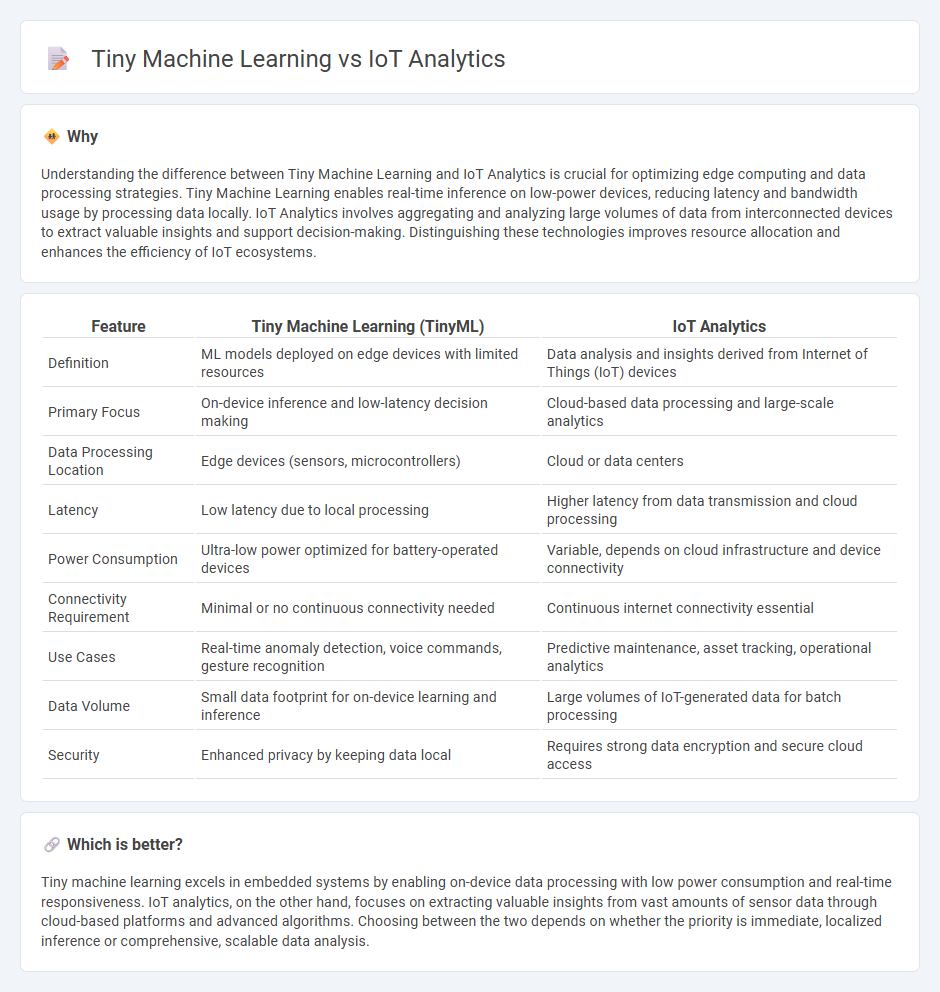
Tiny Machine Learning (TinyML) enables on-device AI processing with minimal power and memory, optimizing edge devices for real-time decision-making. IoT Analytics focuses on aggregating and analyzing vast data streams from connected devices to extract actionable insights and improve system performance. Explore further to understand the distinct roles and applications of TinyML and IoT Analytics in transforming modern technology.
Why it is important
Understanding the difference between Tiny Machine Learning and IoT Analytics is crucial for optimizing edge computing and data processing strategies. Tiny Machine Learning enables real-time inference on low-power devices, reducing latency and bandwidth usage by processing data locally. IoT Analytics involves aggregating and analyzing large volumes of data from interconnected devices to extract valuable insights and support decision-making. Distinguishing these technologies improves resource allocation and enhances the efficiency of IoT ecosystems.
Comparison Table
| Feature | Tiny Machine Learning (TinyML) | IoT Analytics |
|---|---|---|
| Definition | ML models deployed on edge devices with limited resources | Data analysis and insights derived from Internet of Things (IoT) devices |
| Primary Focus | On-device inference and low-latency decision making | Cloud-based data processing and large-scale analytics |
| Data Processing Location | Edge devices (sensors, microcontrollers) | Cloud or data centers |
| Latency | Low latency due to local processing | Higher latency from data transmission and cloud processing |
| Power Consumption | Ultra-low power optimized for battery-operated devices | Variable, depends on cloud infrastructure and device connectivity |
| Connectivity Requirement | Minimal or no continuous connectivity needed | Continuous internet connectivity essential |
| Use Cases | Real-time anomaly detection, voice commands, gesture recognition | Predictive maintenance, asset tracking, operational analytics |
| Data Volume | Small data footprint for on-device learning and inference | Large volumes of IoT-generated data for batch processing |
| Security | Enhanced privacy by keeping data local | Requires strong data encryption and secure cloud access |
Which is better?
Tiny machine learning excels in embedded systems by enabling on-device data processing with low power consumption and real-time responsiveness. IoT analytics, on the other hand, focuses on extracting valuable insights from vast amounts of sensor data through cloud-based platforms and advanced algorithms. Choosing between the two depends on whether the priority is immediate, localized inference or comprehensive, scalable data analysis.
Connection
Tiny machine learning enables real-time data processing on low-power IoT devices, enhancing efficiency and autonomy in IoT ecosystems. IoT analytics gathers and interprets vast datasets from interconnected devices, driving smarter decision-making and predictive maintenance. Together, they optimize resource usage and improve the overall performance of Internet of Things networks.
Key Terms
Edge Computing
IoT analytics leverages large-scale data processing to extract insights from interconnected devices, optimizing operational efficiency and predictive maintenance in smart systems. Tiny Machine Learning (TinyML) focuses on deploying lightweight models directly on edge devices, enabling real-time decision-making with minimal latency and reduced bandwidth dependency. Explore the advancements in edge computing to discover how these technologies revolutionize IoT solutions.
Sensor Data
IoT Analytics enables real-time processing and analysis of sensor data by leveraging cloud computing and big data technologies, providing actionable insights for diverse applications. Tiny Machine Learning (TinyML) optimizes sensor data processing directly on low-power embedded devices, minimizing latency and reducing communication costs. Explore how integrating IoT Analytics with TinyML can revolutionize sensor data management and enhance operational efficiency.
Model Compression
IoT analytics demands efficient data processing on edge devices, where tiny machine learning (TinyML) excels by enabling lightweight model compression techniques that reduce computational load and memory usage. Model compression methods such as quantization, pruning, and knowledge distillation are integral to optimizing TinyML for IoT environments, facilitating real-time analytics and lower power consumption. Explore the latest advancements in model compression to enhance IoT analytics performance with TinyML.
Source and External Links
AWS IoT Analytics - AWS IoT Analytics automates the analysis of IoT data by filtering, transforming, and enriching it before analysis.
What is IoT Analytics? - IoT analytics involves collecting, processing, and analyzing data from IoT devices to gain meaningful insights for decision-making.
What Is IoT Analytics? - IoT analytics analyzes data from connected devices to enhance decision-making and operational outcomes by capturing, processing, and applying logic to the data.
 dowidth.com
dowidth.com